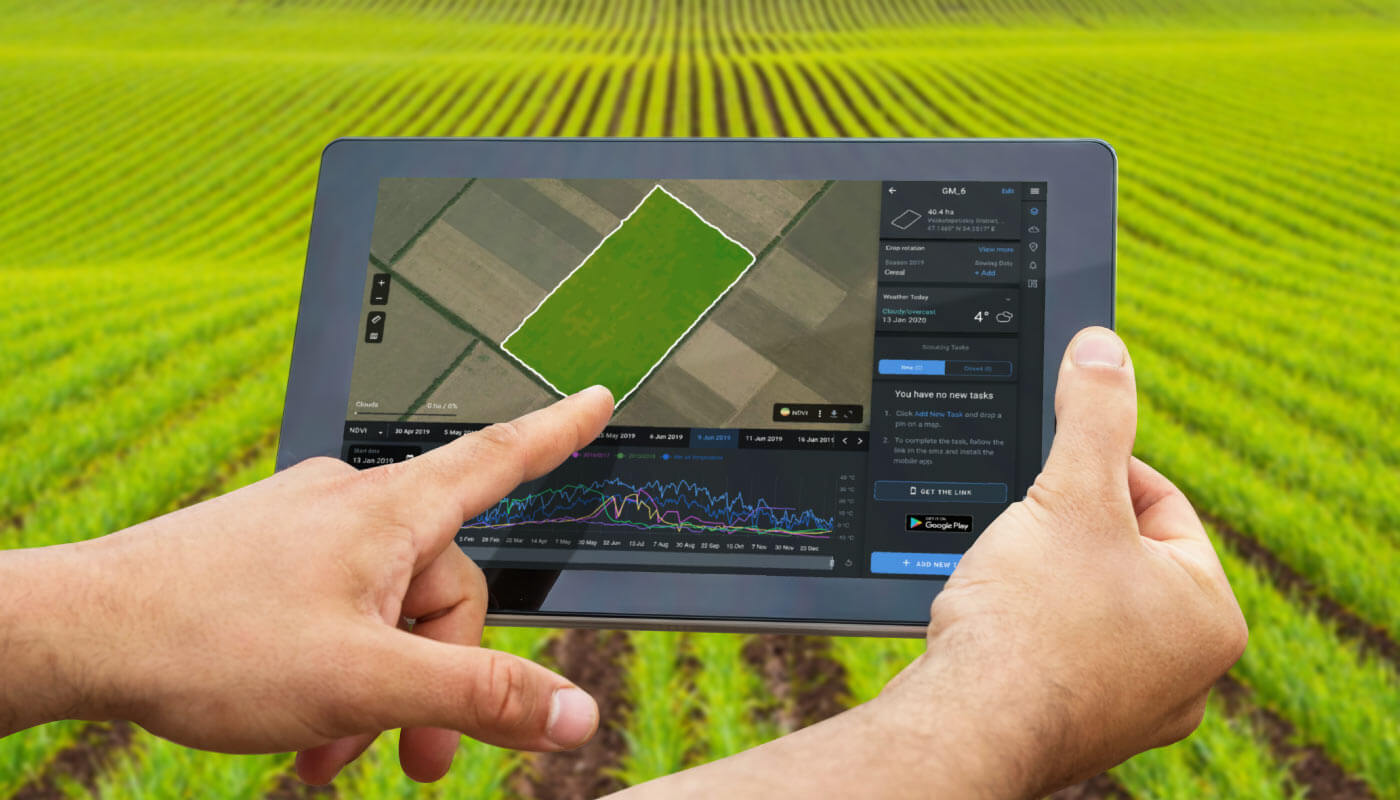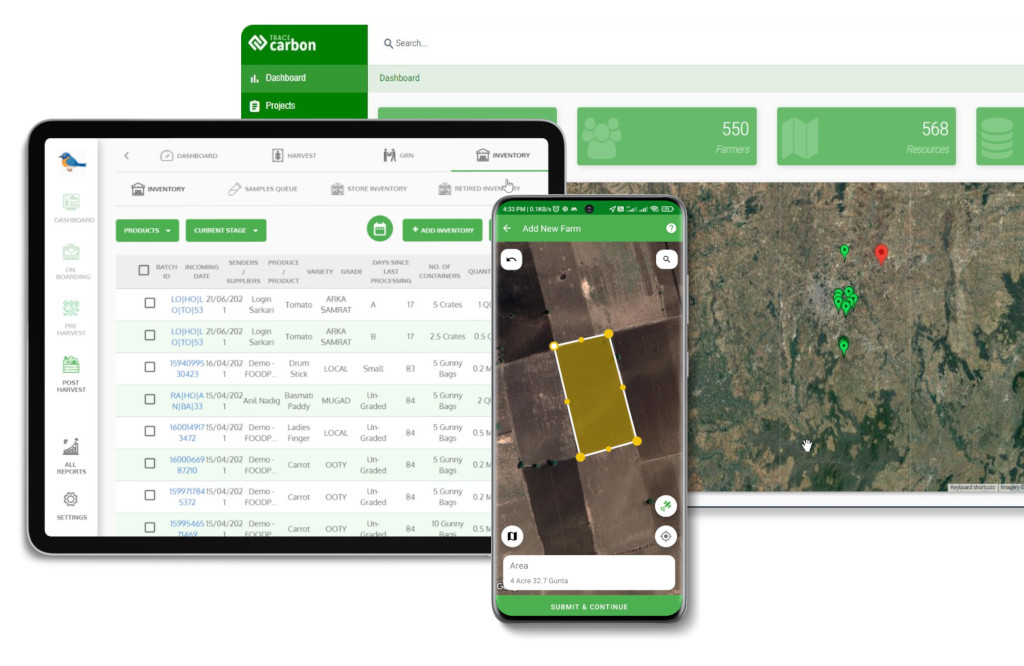Contact: +91 99725 24322 |
Menu
Menu
Quick summary: Measuring farm sustainability metrics is crucial in promoting sustainable agriculture and tackling climate change. This blog explores the importance of measuring sustainability metrics, the different metrics available and how they can be used to improve farm practices and reduce environmental impact.

Everyone’s talking about sustainability — but not enough are measuring it. In agriculture, good intentions alone won’t reduce emissions, prevent deforestation, or improve soil health. That’s why more agri-businesses, ESG teams, and certification bodies are turning their focus toward farm sustainability metrics — the tangible, field-level indicators that move sustainability from buzzword to business strategy.
According to IPCC, agriculture and land-use change are responsible for approximately 23% of global greenhouse gas emissions. To address this issue, sustainability metrics are needed to monitor and reduce emissions from agriculture practices
Many teams don’t know what to measure, how to collect it at scale, or how to turn raw farm data into actionable insights for reporting, compliance, or decision-making. The result? Missed certification opportunities, inconsistent ESG reporting, or worse — buyer trust eroding due to vague or unverifiable sustainability claims.
KeyTakeaways
Most people in agri-business want to be more sustainable. But here’s the real challenge:
How do you know if your farm or supply chain is actually becoming more sustainable… if you’re not measuring anything?
That’s exactly where farm sustainability metrics come in.
They’re not just numbers — they’re your proof points. They tell the story of how a crop was grown, what impact it had on the environment, who was involved in producing it, and whether the process aligns with your sustainability goals, ESG frameworks, or certifications.
Farm sustainability metrics are quantifiable indicators that measure a farm’s environmental footprint, social responsibility, and economic viability. These aren’t vague labels like “eco-friendly” — they’re trackable data points tied to farming practices on the ground.
Farm sustainability data is a bridge between intention and impact — between saying “We farm responsibly” and being able to prove it with clean, auditable data.
To make it easier, farm sustainability metrics generally fall into three categories:
These help measure how the farm affects the ecosystem, including:
Sustainability also means fairness and inclusion:
Because a sustainable farm also has to be viable:
In today’s regulatory and market landscape, farm sustainability metrics are more than nice-to-have. They’re essential for:
If you’re a sustainability lead, ESG manager, or agri-exporter, you’ve likely asked:
The answer? It starts by knowing what to track, and choosing the right tools to collect, verify, and use that data at scale.

If you’re serious about sustainability — not just in principle, but in practice — then you need to know what’s happening at the farm level. Because that’s where your ESG story starts.
But here’s the problem many businesses face:
“We want to prove we’re sustainable… but what exactly do we measure?”
The truth is, you can’t improve what you don’t track. And you definitely can’t defend sustainability claims (to buyers, certifiers, or regulators) without concrete, farm-level metrics.
Why it matters:
Deforestation is a deal-breaker for EUDR, ESG investors, and premium buyers. You need to know when and where land was cleared, and whether your sourcing overlaps high-risk zones.
Track with: GPS mapping, land-use history, satellite overlays

Why it matters:
Soil is the foundation of regenerative and organic agriculture. Poor soil = poor yield, higher input costs, and long-term degradation.
Track with: Field assessments, lab tests, farmer self-reports
Why it matters:
Over-irrigation and contamination harm both the environment and community relations. Water stewardship is a growing focus in certifications and buyer scorecards.
Track with: Irrigation logs, runoff monitoring, water source quality tests
Discover how a leading climate-tech company used the TraceX DMRV Platform to track water usage, monitor health indicators, and drive real, on-ground change for communities in India.
Read the case study to learn how data, transparency, and purpose came together to make water security and public health a shared success.
Why it matters:
Pesticides and fertilizers affect biodiversity, emissions, and human health. Excessive use can disqualify you from organic or Rainforest Alliance standards.
Track with: Input logs (type, quantity, date), farmer declarations
Discover how automating input distribution with digital records can boost productivity, reduce waste, and give you real-time visibility into what’s happening on the ground.
Read the blog to see how smart input management leads to smarter yields — and happier farmers.
Why it matters:
Monoculture systems are vulnerable to climate and market shocks. Crop rotation, cover crops, and mixed farming = resilience + ecosystem health.
Track with: Farm activity records, crop maps, biodiversity scores
Why it matters:
CSRD and Scope 3 reporting require emissions data from the source. This is a must for any brand claiming low-carbon or regenerative practices.
Track with: Activity-based emission calculators, satellite proxies, lifecycle tools
Why it matters:
Sustainability isn’t just environmental — it’s economic. Tracking income, access to premiums, and cost of production supports ethical sourcing goals.
Track with: Surveys, cost/yield tracking, buyer premium logs
Why it matters:
Forced labor, child labor, and unsafe conditions can break trust in seconds — especially in high-risk regions. Investors and certifiers are watching.
Track with: Worker rosters, training records, grievance mechanisms
See how agribusinesses are leveraging TraceX’s Farmer Profiling feature to identify, monitor, and prevent child labor risks at the source — with greater transparency and accountability.
Read the case study to learn how profiling farmers helps protect vulnerable communities and build ethical, responsible supply chains from the ground up.
Why it matters:
How waste is handled — from chemical containers to crop residue — affects safety, soil, and water. It’s also a key factor in environmental certifications.
Track with: Farm waste logs, photo uploads, collection records
Why it matters:
None of the above matters if you can’t link data back to the source. Plot-level traceability creates a foundation for credible ESG reporting and real-time risk management.
Track with: Farmer profiles, batch IDs, geo-tagged activity logs
Your goal isn’t just to collect data.
It’s to build a sustainable supply chain you can defend — and improve.
By focusing on these 10 metrics, you’re not only meeting compliance and certification needs — you’re future-proofing your sourcing and building trust with buyers, regulators, and your own team.
You already know that sustainability starts on the farm.
But here’s the reality most ESG and sourcing teams face:
“We know what we need to measure… but how do we actually collect this data — at scale, from thousands of smallholders, in remote regions with no internet?”
It’s a fair question. Because spreadsheets, WhatsApp messages, and field notebooks don’t scale — and they definitely don’t hold up during a certification audit or EUDR inspection.
The good news? With the right tools and workflows, you can collect credible farm-level sustainability metrics without overwhelming your teams — or your farmers.
Forget relying on signal bars. The best systems are designed for real-world agri conditions — where connectivity is patchy and field agents are working in rural villages or forest-adjacent zones.
Platforms like TraceX offer mobile apps that:
No data gaps. No excuses. No farmer left out due to location.

FPOs and cooperatives are trusted by farmers — and they’re your best channel for data collection, onboarding, and training.
With guided digital workflows, your field staff or lead farmers can:
You get higher adoption and more accurate data — with minimal friction.
This is where everything comes together:
Your data becomes traceable, verifiable, and audit-ready when each sustainability metric is tied to:
So now, when a buyer or auditor asks,
“Can you prove this claim came from a certified, deforestation-free farm?”
You can say: “Yes — and here’s the exact plot, declaration, and timeline.”
You turn every metric into a compliance asset — not just a field note.
Audits are stressful. Especially when you’re pulling data from multiple places and trying to “fill in the gaps” under pressure.
With a digital traceability system, every action — whether it’s a fertilizer application, water usage log, or biodiversity declaration — is:
Which means your sustainability report isn’t just accurate — it’s audit-proof.
You stop scrambling for proof. You start leading with confidence.

Let’s say you’ve done the hard work: you’ve onboarded farmers, mapped plots, collected declarations, and captured sustainability practices in the field.
But what’s next?
“How do we move from collecting raw data to showing real, credible sustainability impact?”
That’s the question sustainability leads, ESG teams, and procurement heads are all asking — especially with growing pressure from auditors, regulators, and global buyers.
When captured and structured right, farm sustainability metrics don’t just sit in a dashboard — they drive real-world results.
When your data is geo-tagged, time-stamped, and tied to individual farms, your ESG disclosures write themselves. You’re not just reporting on environmental goals — you’re showing how your sourcing directly contributes to:
You’re no longer explaining your sustainability strategy — you’re proving it.
Auditors don’t want promises — they want records.
With verified farm data in place, you can streamline:
Instead of scrambling for paper trails, you walk into audits prepared, confident, and in control.
Buyers are getting smarter — and more selective. Whether you’re selling coffee, spices, cocoa, or rubber, buyers want traceable, ethically sourced goods — and the proof to back it up.
When you can show:
Your farm data becomes a market access tool, not just a compliance checkbox.
Farmers can use their own data to improve yields, reduce waste, or optimize input use.
Meanwhile, your sustainability and procurement teams can:
In short: You go from reacting to leading — using real data to drive smarter strategy across your supply chain.

The TraceX Farm Management Platform is purpose-built to solve the real-world hurdles agri-businesses face when trying to implement and prove sustainable practices at the ground level.
At the end of the day, sustainability is only as strong as your ability to measure it — and that starts at the farm. Tracking the right metrics helps agri-businesses move beyond checkboxes and certifications toward real, data-driven impact that builds climate resilience, buyer trust, and operational transparency.
Whether you’re managing 100 farmers or 10,000, knowing where you stand helps you grow — responsibly, credibly, and profitably.
Key metrics include land use change, soil and water health, input usage, biodiversity, carbon footprint, labor practices, and traceability — all of which help track and improve sustainability performance.
Using mobile-first, offline-ready platforms like TraceX allows field agents and farmers to capture GPS, input logs, and declarations — even without internet connectivity.
Yes! Verified, time-stamped farm data supports faster, smoother audits and regulatory compliance across frameworks like EUDR, CSRD, Rainforest Alliance, and Organic.
